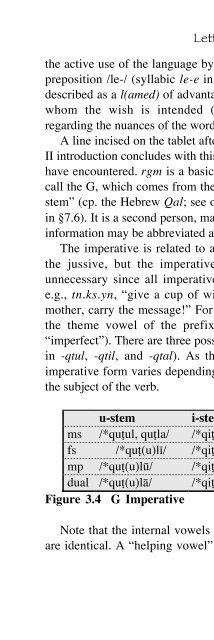A Primer on Ugaritic: Language, Culture, and Literature - enenuru
A Primer on Ugaritic: Language, Culture, and Literature - enenuru
A Primer on Ugaritic: Language, Culture, and Literature - enenuru
Create successful ePaper yourself
Turn your PDF publications into a flip-book with our unique Google optimized e-Paper software.
Letters 51<br />
the active use of the language by several centuries. The use of the<br />
prepositi<strong>on</strong> /le-/ (syllabic le-e in Ug 5 130 III, 5´) here may be<br />
described as a l(amed) of advantage, for it indicates the pers<strong>on</strong> for<br />
whom the wish is intended (see Sivan, Grammar, 195–97)<br />
regarding the nuances of the word “to”).<br />
A line incised <strong>on</strong> the tablet after this line indicates that the Type<br />
II introducti<strong>on</strong> c<strong>on</strong>cludes with this word, the first <strong>Ugaritic</strong> verb you<br />
have encountered. rgm is a basic form of the verb, which we will<br />
call the G, which comes from the German Grundstamm, or“basic<br />
stem” (cp. the Hebrew Qal; see overview of <strong>Ugaritic</strong> verbal stems<br />
in §7.6). It is a sec<strong>on</strong>d pers<strong>on</strong>, masculine, singular imperative. This<br />
informati<strong>on</strong> may be abbreviated as G 2ms impv.<br />
The imperative is related to a short prefixed verb form called<br />
the jussive, but the imperative lacks a prefix. The prefix is<br />
unnecessary since all imperative forms indicate sec<strong>on</strong>d pers<strong>on</strong>;<br />
e.g., tn.ks.yn, “give a cup of wine!”, sûpsû.}um.ql.bl, “OSun, my<br />
mother, carry the message!” For vocalizati<strong>on</strong> the imperative uses<br />
the theme vowel of the prefix c<strong>on</strong>jugati<strong>on</strong> (i.e., the Hebrew<br />
“imperfect”). There are three possible theme vowels: u, i, <strong>and</strong> a (as<br />
in -qtul, -qtil, <strong>and</strong> -qtal). As the following chart indicates, the<br />
imperative form varies depending up<strong>on</strong> the gender <strong>and</strong> number of<br />
the subject of the verb.<br />
u-stem i-stem a-stem<br />
ms /*qutul, qutla/ /*qitil, qitla/ /*qatal, qatla/<br />
fs /*qut(u)lˆä/ /*qit(i)lˆä/ /*qat(a)lˆä/<br />
mp /*qut(u)luœ/ /*qit(i)luœ/ /*qat(a)luœ/<br />
dual /*qut(u)laœ/ /*qit(i)laœ/ /*qat(a)laœ/<br />
Figure 3.4 G Imperative<br />
Note that the internal vowels of the different forms of G impv<br />
are identical. A “helping vowel” is inserted between the first two


